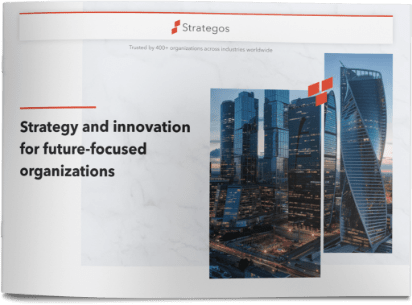Taking our own medicine
We at Strategos have taken a dose of our own innovation medicine recently as we have built out a major improvement to one of our offerings – management innovation.
Over the past 20 years, most of our work with clients has focused on helping them to create and realize innovative strategies and new offering concepts. But what about the entire management infrastructure that an organization uses to deliver value to its customers?
Until a few years ago, we had a bias (an orthodoxy in our own language): we considered management innovation too close to operations, which we equated with efficiency, for us to add value.
Our (as it turns out, incorrect) assumption: we’re not a quant shop, and that’s what is needed to address process and system improvement, so it’s best for us not to play there.
But clients with the ability to engage any consulting firm kept asking us for help with their processes. Clearly there was a need, a gap in available offerings.
As we thought more about this, we came to the realization that we could apply many of the approaches that we apply to strategic and offering innovation, in new ways, to address clients’ needs to re-think existing processes and systems.
A principles based approach to management innovation
The result was a “principles-based” approach to management innovation that stays away from simply troubleshooting and de-bottlenecking existing processes in favor of understanding, and then challenging, the implicit assumptions behind current processes and behaviors.
For instance, our Orthodoxy perspective that helps to identify hidden assumptions and blind spots in management thinking turned out to be immensely useful when we focused it on understanding discrete processes or functions. By asking in a structured way “what do you have to believe is important in order to act the way you do?” we were able to identify the underlying current principles that drove processes or department functions or policies.
We then challenged the current principles. Were these design principles still appropriate for the future given changes in customer and stakeholder needs, our clients’ business objectives, and the external environment? If not, what were the appropriate future principles?
Focusing the client’s dialogue on current and future principles (the “why”) helped to develop a shared point-of-view and removed a lot of defensiveness around turf, and also opened up creativity to imagine a future process based on radically different principles. Once the future principles were clarified, we helped clients to revise, refresh, and sometimes revolutionize the process or function or policy under study (the “what” and “how”) to reflect those new principles.
Our clients applauded. We high-fived.
Implementing management innovation
Of course, conception is one thing; implementation another.
The first time a client asked us to stick around to help them with implementation of their shiny new process, our eyes were opened. We learned how truly transformational the new principles could be.
Transformational, but not easy! While the change process was far from simple, continued reliance on the new principles as the “North Star” behind action enabled the organization to stay on course as they made dramatic changes to roles, organizational structure, and decision rights:
Roles – The new process redefined how team members contributed and how functions interacted. Employees who were traditionally seen as “support” were now asked to be full team members. Their role changed from giving advice based on areas of expertise to making business judgments and putting their names behind recommendations.
Organizational structure – The new team structure, in which individuals now committed to a project much further into its development than before, required some departments to reorganize. Functional support groups were essentially turned inside out to interface with the business more directly. Silos began to break down.
Decision rights – By empowering teams to take ownership, make judgments and propose recommendations, the existing decision makers had to let go. Some did this more willingly than others. Shifting control and decision making from a top heavy approach to a distributed approach has, not surprisingly, taken some time. The results, however, are overwhelmingly positive with the organization feeling engaged and leadership feeling informed.
When you add up all these changes, the process redesign transformed the culture of the company. Team members, functions and executives were each asked to contribute in a different way; and they did. Mandates turned into dialogues. Hand-offs turned into collaboration. Silos turned into networks.
As it turns out, applying our proven innovation models to clients’ critical processes and systems has proven to be as powerful as any other part of our innovation work. Good thing we finally listened carefully to our clients’ requests, empathized with their unmet needs, and challenged our own orthodoxies!
Want to read more about management innovation?
Focusing innovation inside





